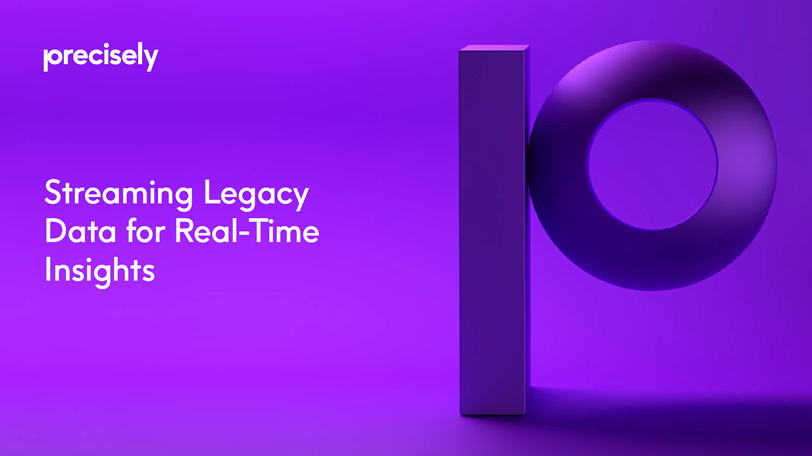eBook
Streaming Legacy Data for Real-Time Insights
Read this eBook to learn more about the challenges to streaming legacy data. And, see how Precisely’s Data Integration Solutions can help your business stream real-time application data from legacy systems, such as mainframes, to mission critical business applications and analytics platforms that demand the most up-to-date information for accurate insights.
Secret Sauce: Streaming Legacy Data for Real-Time Insights
In today’s digital economy, data is the lifeblood of any organization.Analytics is the primary means through which any organization today derives its competitive advantage, yet extracting the right information at the right time is often a challenge. Data remains locked away in silos or arrives too late to be of any use. And even if the data is accessible and correct, it’s missing essential elements for the operational or analytical task at hand. Given the real-time demands and 24/7 requirements of the modern age, organizations need a constant stream of data to keep their insights fresh and their applications up to date.
Streaming data helps process large amounts of data from many different sources across the business. It helps to collect data from a multitude of sources that drive key use cases from data science to artificial intelligence and machine learning. Data Streaming fuels these processes and helps organizations stay competitive with up-to-the-minute insights.


To build a successful streaming environment, it is important to note and understand several key trends that proliferate the market:
- Scaling data integration across the organization is still a challenge – most businesses struggle with having a single source of truth, having the right staff in place, data quality and data governance
- Organizations that have successfully implemented streaming data capabilities have seen the benefits of real-time insights by generating more revenue and shortening SLAs
- Many organizations deploy streaming architectures that omit key data sources like the mainframe because extracting data form these systems is challenging.
Value of Streaming Data
Streaming data pipelines bring a lot of value to the business, such as:
Real-time insight
Streaming data enables organizations to access data as soon as it enters the source system. This real-time feedback helps businesses to make better, faster decisions and maintain a competitive edge.
Break down data silos
In Precisely’s 2023 Data Integrity Trends and Insights Report, more than half (54%) of respondents cite that breaking down data silos and improving data access improves their decision making. Building
data pipelines helps to make all enterprise application data accessible and usable – and in turn begins to break down the data silos that commonly exist within large environments.


Evolve revenue generating business applications
In scenarios where data is generated on a continuous basis, streaming data pipelines can help drive the collection of that data. As data collection grows over time, the data can then be fed into more complex processes, helping to create the foundation for next generation of revenue generating business applications that are driven by AI or machine learning.
Improve customer experiences
Streaming data can determine correlations, changes, and common behaviors over time, helping organizations to gain insights into the needs of their customers. By leveraging these insights, organizations can create more customized customer experiences. These enhanced experiences can result in lower customer churn and help drive new customer revenue channels.
Importance of Legacy Data
Even with the growth of next-gen technologies, legacy systems (i.e. mainframes) still play a critical role within many businesses. More than 70% of Fortune 500 enterprises continue to use mainframes for their most crucial business functions. Mainframes often hold critical information – from credit card transactions to internal reports.
Most large enterprises have made major investments in mainframe data environments over many years and will not be leaving these investments anytime soon. It is estimated that 2.5 billion transactions are run per day, per mainframe across the world. This high volume of data is one that organizations cannot choose to ignore or neglect. Additionally, mainframes are unmatched when it comes to the volume of transactions they can handle and cost-effectiveness. As a result, these environments contain the mission-critical data that organizations posses, and in turn, power the strategic initiatives driving the business forward – machine learning, AI and predictive analytics.
Business insights, artificial intelligence and machine learning efforts are only as good as the data they use. Leaving mainframe data out of the equation when building strategic initiatives risks omitting critical information that has an immense impact on business outcomes. Specifically, neglecting mainframe data from strategic initiatives results in:
- Diminished value of an organization’s data and analytic investments
- Analytics that are not accurate or complete
- Large, rich enterprise datasets are never analyzed
“Business insights, artificial intelligence and machine learning efforts are only as good as the data that is being fed in and out of them.”
Legacy Data + Streaming – Easier Said Than Done

With so much valuable data on the mainframe, the most logical thing to do would be to connect legacy to cloud applications. However, many road blocks merge when businesses attempt to stream data between new and legacy sources. As a result, integrating e-data from these systems is often easier said than done. Common challenges of streaming legacy data are:
Data bottlenecks
Integrating mainframe data into newer cloud technologies, is problematic because there is no native connectivity and processing capabilities in these new systems for mainframe data. The time and effort it takes to load hundreds, or even thousands, of database tables into a modern data platform – combined with inefficient use of system resources – can create a data bottleneck that hampers your streaming data projects from the start.
Complex copybooks
Most tools cannot handle variable length records from legacy systems without padding to max length, grinding processing to a crawl and often requiring multiple redefines. Additionally, legacy systems are often not readily compatible with affordable open-source analytic frameworks and data formats for analysis.
Data Governance
When moving data to the cloud, most tools must unpack, expand, and convert data to human readable format. However, performing these conversions causes several different issues to the original mainframe
data, such as:
- Copybook no longer matches data.
- Metadata is no longer reliable.
- Record descriptors are lost.
- No copy kept of data before modification.
- Data is bloated so processing chokes
Real-time Change Data Capture
With data flowing between mainframe and business applications, the other challenge becomes the need for ongoing real-time change data capture. Just like any other system feeding a business application, the data from the mainframe must remain up to date. This means that there is a need to track and detect changes in the data as they occur. The challenge then becomes how fast these changes are captured as data from the mainframe often changes very rapidly. Most of the time, businesses are not able to capture these changes in real-time and, therefore, lose the value if this data.

Stream Your Legacy Data
Realizing the full value of your organization’s data for actionable insights and a competitive edge requires the ability to connect to legacy systems. To do this, the business needs to invest in solutions that enable these connections and help drive the most value to business applications.
Precisely’s change data capture solutions, including the Data Integrity Suite’s Data Integration Service, are designed to help businesses stream real-time application data from legacy systems, such as mainframes, to mission critical business applications and analytics platforms that demand the most up-to-date information for accurate insights (e.g., fraud detection). Precisely’s Data Integration solutions enables businesses to:
- Have a reliable transfer of data from legacy systems to business applications, even if connectivity fails on either side.
- Keep data in sync in real-time without overloading networks, affecting the source database performance or the need for specialized skills.
- Support both cloud and hybrid architectures through a variety of application topologies that can be combined, through a variety of application topologies.
Data Integration is often just the beginning of the journey to Data Integrity. Precisely’s Data Integrity Suite not only provides users with a simple mechanism to build and monitor real-time replication pipelines, but also provides access to additional services to understand and remediate Data Quality, to monitor how data values change over time with Data Observability, and add Data Governance standards to help manage the multitude of sources and targets feeding your analytics warehouse.
Download the PDF version
DownloadLearn how Precisely can support your enterprise.
Get in touch